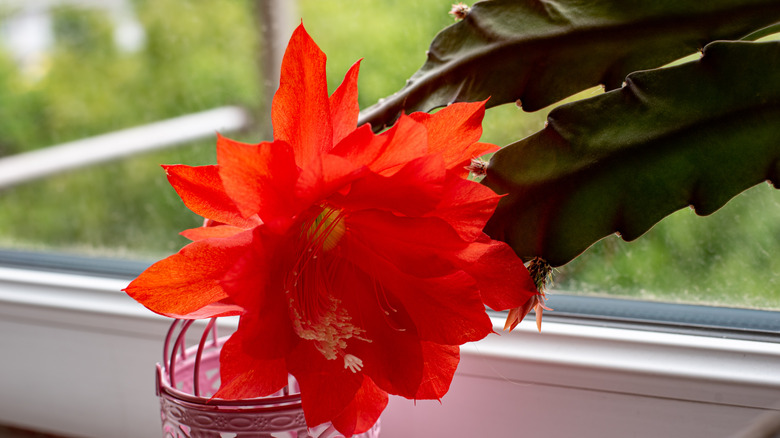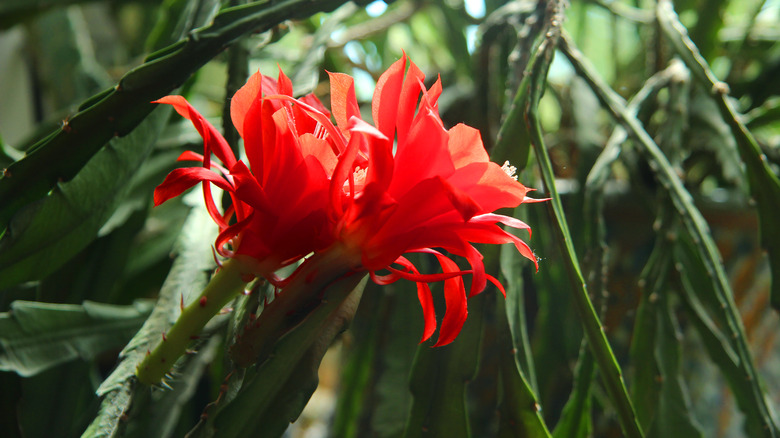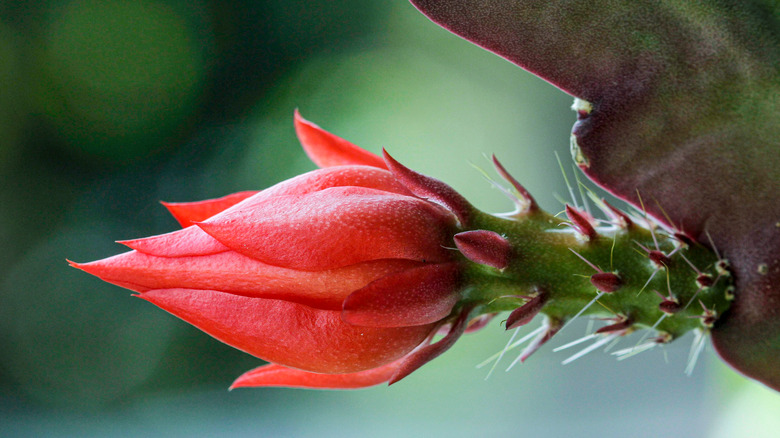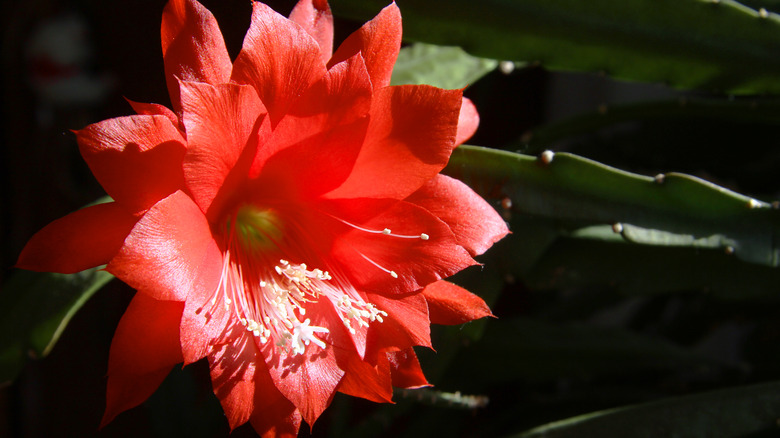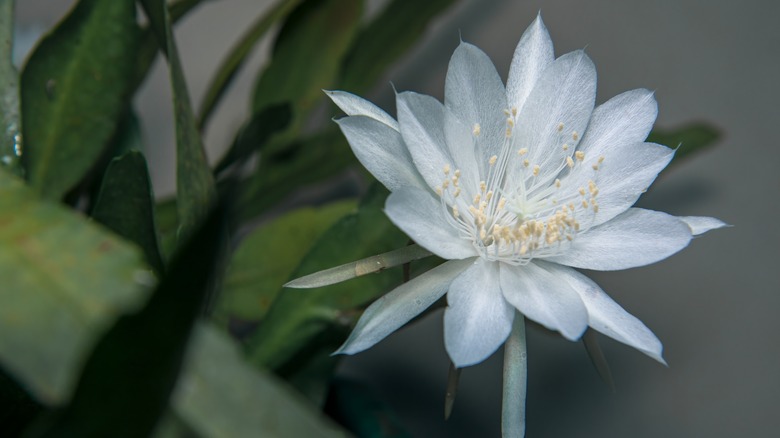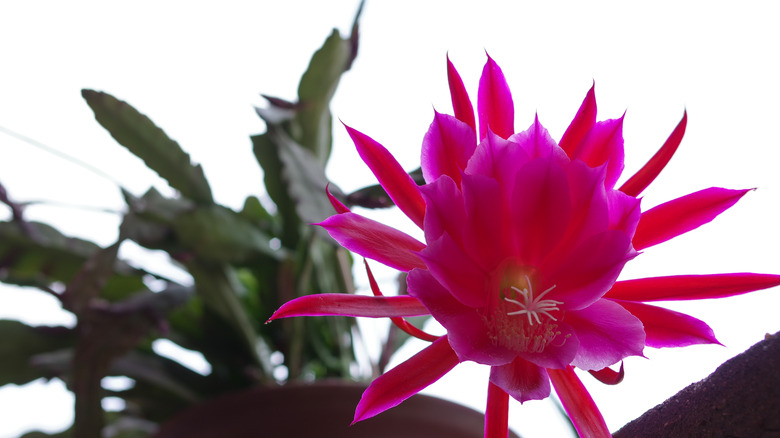How To Care For A Red Orchid Cactus
The red orchid cactus has gone by a few different scientific classifications over the years. First referred to as Epiphyllum ackermannii, the epiphytic cactus is now called Discocactus ackermannii. In the past, it has also been named Cactus ackermannii, Cereus ackermannii, Phyllocactus ackermannii, and Nopalxochia ackermannii, as per GardensOnline. When identifying a red orchid cactus, you'll notice its flat, semi-erect green stems. These stems are branched with scalloped edges, and unlike most cacti, they are spineless.
According to World of Succulents, the branches stem from a larger, rounder trunk in the middle of the plant, which can grow up to 7 inches tall. This plant gets its common name from its gorgeous funnel-shaped flowers that can become 6 inches in diameter and bloom in different shades of bright red. These flowering cacti, native to the tropical regions of Oaxaca and Veracruz, Mexico, are somewhat high-maintenance plants. To keep them happy, you need to water, reposition, and check on their health frequently. These are not the type of cacti that you can plant and forget about.
How to use red orchid cactus in the garden
Because red orchid cacti need consistent temperatures of 45°F to 70°F, they do best as indoor plants in most regions, SFGate notes. However, if you live in USDA hardiness zones 10 or 11, you may find some success when planting them in outdoor containers or hanging baskets. You should not plant this type of cacti directly into your garden; because it is an epiphytic cactus, it grows on tree trunks and branches in nature, explains The Spruce. This means typical soil will kill it. Instead, you need a well-draining potting mix supplemented with pumice, perlite, or bark.
Choose to grow your red orchid cactus in some type of pot that you can leave on your porch. This will ensure it gets the right amount of sunlight and attention. Doing this will also make the plants easier to move when you know temperatures outdoors will get extremely hot or cold.
How to grow a red orchid cactus
Though it can take a long time, growing a red orchid cactus can be extremely rewarding. They can be cultivated from seeds or cuttings. However, most hobbyist gardeners prefer the cutting method, probably because growing red orchid cacti from seeds can take up to 15 years to reach their blooming stage, as told by House Plants Expert. Propagation from cuttings takes much less time, and all you need is sterile scissors, well-draining potting soil, and a small container.
To propagate a red orchid cactus from cuttings, start by removing a 1-inch stem or longer with sterile scissors to avoid infection. Succulent Alley then recommends laying the cutting out to dry for a few weeks until its wound calluses. Next, plant your stem in a pot of moist, well-draining soil. Depending on its size, you may need a stick to help it stay upright. The red orchid cactus stem should take root within one to three months with regular watering, and at this time, you can repot your cactus into a more suitable container.
How to care for a red orchid cactus
Caring for a red orchid cactus can take quite a bit of time, especially before they reach maturity. The most important thing to follow through is its watering schedule. Though Epiphyllum ackermannii hates being overwatered, going without water for some time can keep it from blooming in the spring and summer, explains World of Succulents. You will need to regularly check the plant's soil to decide when the top 1/3 of the soil has become dry; this is the time to water it.
Proper sunlight is another requirement of the red orchid cactus. When keeping it as a houseplant, you must ensure this plant gets plenty of indirect sunlight. As per SFGate, too much or too little light can cause the cactus' leaves to become yellow or leggy, and the flowers will droop. Fertilizing during the growing season can help your orchid cactus grow more quickly. You should use water-soluble or liquid fertilizer once per month, and finding one that contains less nitrogen will encourage flowering during the spring.
Orchid cactus varieties
Originally named Epiphyllum ackermannii, the red orchid is part of the orchid cactus group that features several different cacti types, says Gardening Know How. However, they look very similar despite being different species. Most of these plants are referred to as Epiphyllum, but other genera of orchid cacti may be categorized under other names such as Selenicereus, Rhipsalis, and Disocactus. All orchid cacti are heat lovers native to the warmer regions of Mexico, Central America, and the Caribbean. Here are a handful of the most popular orchid cactus varieties as described by Leafy Place.
- Epiphyllum oxypetalum "Queen of the Night Cactus" looks quite similar to the red orchid cactus, only its flowers are a stark white. People love this variety because it has a sweet fragrance.
- Disocactus phyllanthoides "German Empress" is a pink version of the orchid cactus which blooms during the day.
- Epiphyllum pumilum features white flowers, but it is distinguishable by the flower's petals which create a star shape.
- Epiphyllum phyllanthus "Climbing Cactus" is an orchid cactus type with smaller white blooms that form atop longer pencil-like stems.
- Disocactus crenatus "Crenate Orchid Cactus" has some of the largest flowers among orchid cactus varieties. Their giant bowl-shaped flowers can grow up to 8 inches wide.
How to repot a red orchid cactus
Repotting a red orchid cactus takes little effort. All you need is well-draining potting soil mixed with perlite, pumice, or another draining supplement and a new container that is only a size larger, House Plants Expert advises. Likely, your red orchid cactus will only need repotting every two years or so because these cacti like to be slightly rootbound, which helps them flower.
When you are ready to repot your cactus, start by gently removing the plant from its container. If you are having trouble with the root removal process, dislodge the soil on the edges of the pot with a flat tool such as a butter knife. Once out of its pot, shake the excess dirt from the roots with your fingers. Then, place it into its new home, backfilling with the fresh potting soil, as explained by World of Succulents. Allow your red orchid cactus to become accustomed to its new container for a few days before watering it for the first time.
